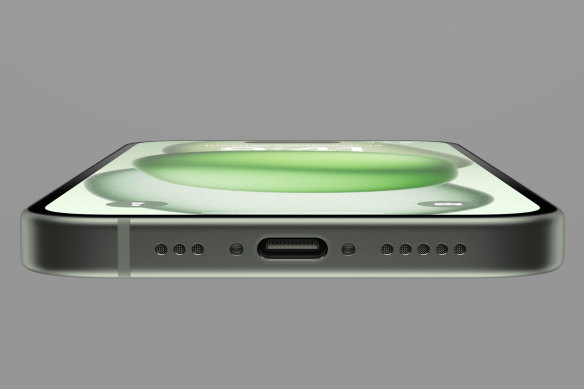
The Pro difference
Aside from the USB-C spec, the new phones differ in a number of ways. The iPhone 15 and 15 Plus borrow a lot more from last year’s 14 Pro than its processor, including its matte glass finish, thinner screen bezels and the dynamic island that serves as a home for notifications and other information. But the always-on display and fast refresh rates remain a Pro-exclusive feature.
The new Pros have titanium cases for the first time and sport a brushed metal look in typically muted Pro colours. The screen borders have shrunk even farther so that the phones are physically smaller than their non-Pro counterparts, and when you pick them up the first thing you notice is that they’re extremely light compared to last year’s steel Pros.
On the side, the Pros have a new button where the mute switch used to be, and you can choose what it does in the phone’s settings. It can mute and unmute your phone of course, or open the camera to a specific mode (and act as the shutter button), activate any Siri shortcut, start a voice recording and more. It has tactile feedback a bit like the Apple Watch’s digital crown, so you can feel that it did something even if you’re pressing it without looking.

The iPhone 15, now with the same connector as your other devices.
How many lenses?
Apple says that the iPhone 15 is like having three cameras in your pocket, even though the main lens array still only has two. What it’s referring to is that the wide lens now has a 48MP sensor, which is big enough that you can crop a full picture out of the middle, in effect giving you a high-quality 2x zoom. I’ll grant that that might be “like” having three cameras, but we’ll need to test a bit more extensively to see how it holds up.
Things get a bit silly on the Pro with the claim that it has seven lenses, although seeing the system in action is impressive. Essentially, the camera app gives you a number of different focal length options for each of the three main cameras, and toggling between them is roughly equivalent to changing lenses on a traditional camera. You can also individually set your favourite, so it always switches to that when you use that lens.
The Pro Max has an exclusive trick of its own here; a 5x optical zoom lens in place of the smaller Pro’s 3x. This is not a periscope lens as had been rumoured, but a new design that Apple calls a tetraprism. Essentially, it bounces light back and forth to create the effect of a long lens without a massive camera bump. It also comes with a new image stabiliser that moves in all three dimensions, and in my brief hands-on I was able to easily focus on faraway faces and lock them.
Yes, they’re more expensive
Most of the new iPhones are between $70 and $100 more expensive than their equivalent iPhone 14. For starting prices that’s $1500 for the iPhone 15, $1650 for the Plus and $1850 for the Pro.
Loading
But in the US, Apple is keeping the prices the same as last year, which would indicate that our local price rise is more to do with currency fluctuations than anything else, given the company works out the prices in US dollars first.
One exception is the $2200 iPhone Pro Max, which has seen an increase to its starting price even in the US. But this is because the least expensive model has 256GB of storage, whereas last year you could choose a 128GB version.
As with every year, it’s worth your while now to look at what the release of the new iPhone has done to previous models’ prices. The iPhone 13 has gone down to $1100, the iPhone 14 to $1300 and the 14 Plus to $1500.
The author travelled to California as a guest of Apple.
Get news and reviews on technology, gadgets and gaming in our Technology newsletter every Friday. Sign up here.









 Add Category
Add Category